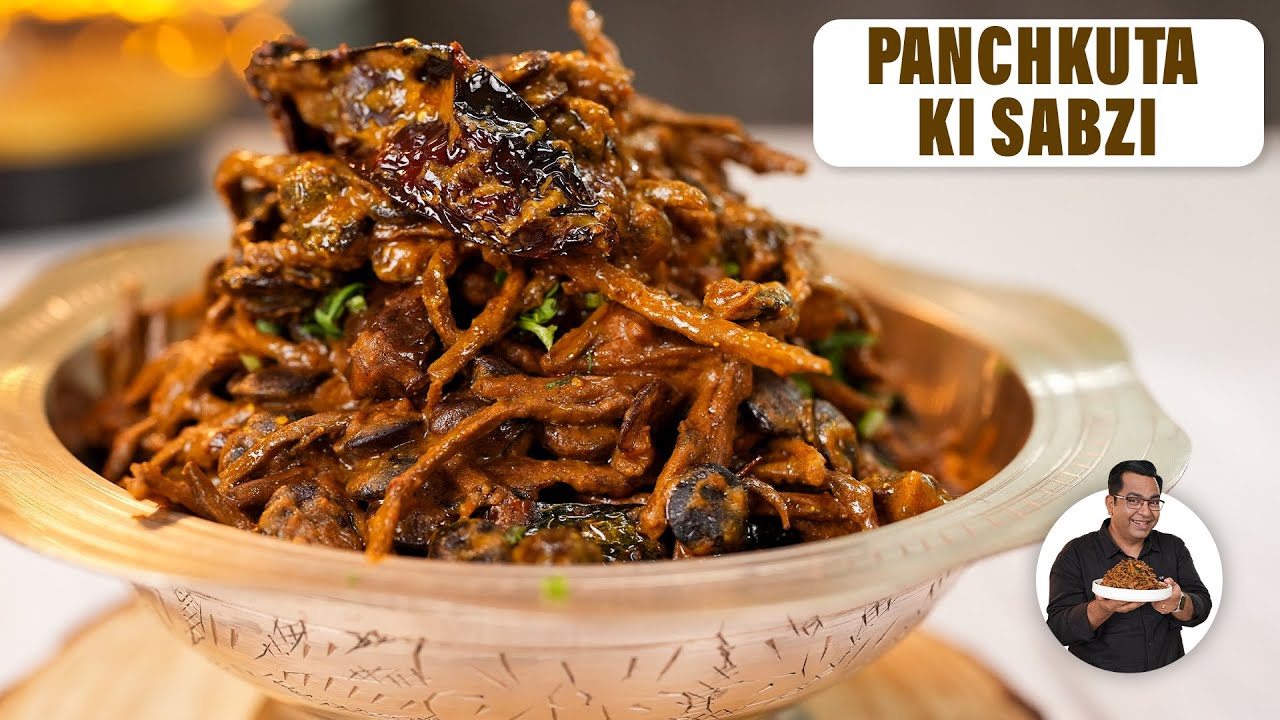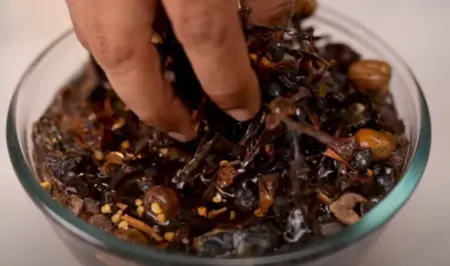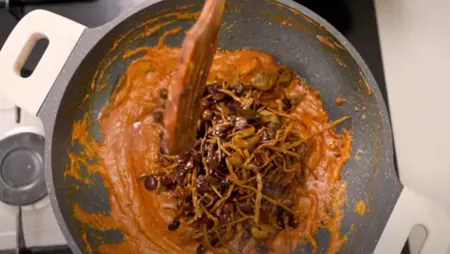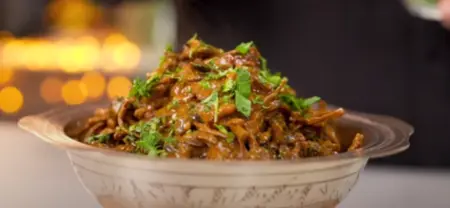
Panchkuta ki Sabzi Recipe

30 Mins

4-5 People

2 Hours
Delicious Panchkuta Ki Sabzi Recipe
Introduction:
Hello, my name is Ajay Chopra and I would like to take you on a journey through the vibrant flavours of Panchkuta Ki Sabzi. Picture the warm smells of spices filling the air, the sizzle of ingredients in the pan, and the anticipation of every delicious bite. But before we get to the recipe, let me tell you a story about the first time I tried this culinary gem.
When I was travelling through Rajasthan many years ago, I came across a small restaurant by the side of the road where locals were enjoying a dish that caught my attention. It was Panchkuta Ki Sabzi, a delightful mix of flavours that stuck with me. Ever since then, I have been interested in its unique flavour and the traditional ways it is cooked.
Panchkuta ki Sabzi Recipe
Portions serving: 4-5
Preparation time: 2 hours
Cooking time: 30 minutes
Calories: 268 cal per portion
Ingredients of Panchkuta ki Sabzi
- 100 gms Panchkuta mix (Sangri, Kumathiya, Ker, Gunda, Sukhi Lal Mirch)
- Water, as required
- 1 tbsp Salt
- 1 tsp Turmeric powder
- 2 tbsp Oil
- 3 pcs Dried red chilli
- ½ tsp Jeera (Cumin seeds)
- ½ tsp Hing (Asafoetida)
- 1 tsp Coriander powder
- 1 tsp Red chilli powder
- ½ tsp Turmeric powder
- ¼ cup Besan (Gram flour)
- 1 tbsp Amchur powder (Dry mango powder)
- ½ cup Curd
- 1 tbsp Raisins
- Fresh coriander, for garnish
Instructions of Panchkuta ki Sabzi
1. Pre-soak Panchkuta Mix: Place the Panchkuta mix in a bowl and rinse it quickly with water. Let the ingredients soak in water for 2-3 hours to enhance their flavors.

2. Prepare the Spice Base: Heat oil in a pan and add dried red chillies. Let them sizzle. Add jeera and hing, allowing them to crackle and release their aroma.
3. Add Spice Blend: Sprinkle coriander powder, red chilli powder, turmeric powder, and salt. Saute the spices until fragrant.
4. Roast Besan: Add besan to the pan and roast it gently until it releases a nutty aroma. Be careful not to over-roast. If the besan becomes too intense, add a splash of water to prevent burning.

5. Incorporate Flavor Enhancers: Add amchur powder, curd, and raisins to the pan. Stir well to combine.
6. Introduce Panchkuta Mix: Add the soaked Panchkuta mix to the pan and mix gently. Cover and let it simmer for 5-6 minutes to allow the flavors to meld.

7. Garnish and Serve: Garnish the dish with freshly chopped coriander for a burst of freshness and visual appeal.
8. Enjoy: Your Panchkuta ki Sabzi is now ready to be served. Enjoy this delightful blend of spices, textures, and aromas with your favorite bread or rice.

About the Recipe:
A traditional Rajasthani dish called Panchkuta Ki Sabzi is a true reflection of the region's food culture. It is made with five main ingredients: ker sangri, kumatiya, gunda, raisins, and dried chilies; these are mixed with a mix of spices and then dried to keep their flavours. When cooked, the dish is tangy, savoury, and slightly sweet.
For Panchkuta Ki Sabzi, the dried vegetables are soaked in water for several hours to make them soft before they are cooked. The spices are then roasted to bring out their flavour and aroma, and they are mixed with the softened vegetables to make a rich gravy. Yoghurt and besan (gramme flour) give the dish a creamy texture, and amchur (dried mango powder) balances out the heat of the spices.
The Panchkuta Ki Sabzi dish is very flexible and goes well with many things, like roti, naan, or rice. It is a popular choice for holidays and special events in Rajasthan, where it is served as part of a traditional thali meal.
Cooking Tips:
- Soak the dried vegetables in water for at least 2-3 hours to soften them before cooking.
- Roast the spices on low heat to prevent them from burning and to enhance their flavor.
- Use fresh yogurt and besan for a creamy texture and rich flavor.
- Adjust the amount of spices and amchur according to your taste preferences.
- Garnish the dish with fresh coriander leaves for added freshness and flavor.
Pairing Guide:
Panchkuta Ki Sabzi goes well with many Indian breads, like roti, naan, or paratha. It also makes a filling meal when served with steamed rice or pulao. To keep the flavours from clashing, serve it with a side of cucumber raita or a tangy salad.
10 Frequently Asked Questions about Panchkuta Ki Sabzi
- What are the main ingredients of Panchkuta Ki Sabzi?
- The main ingredients are ker sangri, kumatiya, gunda, raisins, and dried chilies.
- How long does it take to prepare Panchkuta Ki Sabzi?
- The preparation time is approximately 3-4 hours, including soaking the dried vegetables.
- Can I adjust the spice level of Panchkuta Ki Sabzi?
- Yes, you can adjust the amount of dried chilies and other spices according to your taste preferences.
- Is Panchkuta Ki Sabzi suitable for vegetarians?
- Yes, it is a vegetarian dish made with dried vegetables and spices.
- Can I make Panchkuta Ki Sabzi in advance?
- Yes, you can prepare the dried vegetable mix in advance and store it in an airtight container for up to a month.
- What is the best way to rehydrate the dried vegetables?
- Soak them in water for 2-3 hours or overnight until they become soft and plump.
- Can I freeze Panchkuta Ki Sabzi for later use?
- Yes, you can freeze the cooked dish in an airtight container for up to 2-3 months.
- What is the significance of Panchkuta Ki Sabzi in Rajasthani cuisine?
- It is a traditional dish that reflects the use of locally available ingredients and the culinary heritage of Rajasthan.
- Is Panchkuta Ki Sabzi spicy?
- It has a balanced flavor profile with a combination of tangy, spicy, and sweet flavors.
- What are some variations of Panchkuta Ki Sabzi?
- Some variations include adding additional vegetables such as potatoes or green peas, or adjusting the spice blend according to personal preference.
